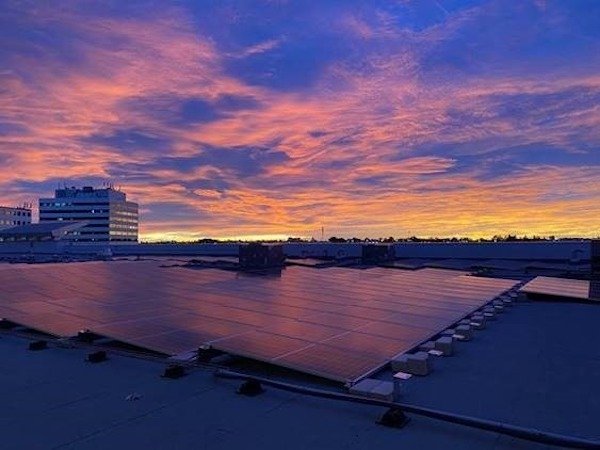- Culture
- Notre équipe
- Services
- Projets
- Médias
- Nos bureaux
- Rechercher
Here comes the sun: Considerations for rooftop solar panelling
- Détails

The search for cleaner, greener energy is giving rise to rooftop solar panels on all property types. And while there are clear advantages to harvesting renewable energy from the sun, important design and installation considerations must be made to ensure those benefits shine.
As RJC Engineers’ Design Guide for Rooftop Solar explains: “In new construction projects, the designer should always consider alerting the owner and design team to the long-term savings that potentially result from designing new roofs for future a PV installation, considering the anticipated rise in the use of solar energy in the future.”
Undoubtedly, adding rooftop solar panels to any building – new or old – comes with design and cost discussions. Addressing these factors early into the design process, and ensuring the benefits of solar energy generation are well understood by all stakeholders, helps teams embrace clean energy solutions.
After all, adds RJC’s guide: “Although solar panels have significant cost savings throughout the life of the building, upgrading existing buildings for solar panels can prove to be a costly undertaking … considering how to make buildings solar ready early in the design process of new building projects can save building owners and operators significant future upgrading costs.”
Types of Solar Panels
The first consideration concerns the type of solar panel technology used to convert sunlight into energy. Today, there are two primary methods:
- Photovoltaics (V), solar panel technology that generates power by using materials that absorb light and produce electrons (aka the photovoltaic effect), such as silicon and arsenide.
- Concentrated solar power (CSP), which are panels comprised of mirrors and tracking systems that concentrate sunlight onto a small heat collector.
Investing in abundant energy
The addition of any PV solar panel system will increase a roof's superimposed dead load (SDL), thereby requiring design elements to accommodate their weight. This can add costs to any new build or renovation, but it's important to remember the long-term savings that will result from using solar power.As RJC Engineers’ Design Guide for Rooftop Solar explains: “In new construction projects, the designer should always consider alerting the owner and design team to the long-term savings that potentially result from designing new roofs for future a PV installation, considering the anticipated rise in the use of solar energy in the future.”
Undoubtedly, adding rooftop solar panels to any building – new or old – comes with design and cost discussions. Addressing these factors early into the design process, and ensuring the benefits of solar energy generation are well understood by all stakeholders, helps teams embrace clean energy solutions.
After all, adds RJC’s guide: “Although solar panels have significant cost savings throughout the life of the building, upgrading existing buildings for solar panels can prove to be a costly undertaking … considering how to make buildings solar ready early in the design process of new building projects can save building owners and operators significant future upgrading costs.”
Solar panel case studies
RJC is eager to continue sparking Canada’s rooftop solar panel industry. In recent years, it has helped clients across Canada arrive at solar panel racking solutions which meet their specific building objectives.
One success story is in full view at the CF Chinook Centre, where RJC worked with CF, ENMAX, Mulvey + Banani, and Resco Energy to install 1900 solar panels in an 800 kW system innovative pilot project. The goal was to test two-way power flow on ENMAX Power's secondary network, a part of the grid that exists in high-density areas and currently only allows one-way power flow due to its highly reliable design.
Another demonstration of rooftop solar power took shape at The Edge in Edmonton, Alberta. This is a 10-storey office building development brought to life by Dub Architects and features a south wall with 560 solar panels that provide 80 per cent of the building's electrical load and represents one of the largest of its kind in Canada. Here again, RJC was proud to help Dub Architects see its vision through by providing structural engineering and structural glass engineering services for this landmark project.
Leaders in solar energy
It’s been years since rooftop solar panelling began in Canada. Thanks to its experience helping clients take advantage of this renewable energy source, RJC looks forward to facilitating clean energy solutions for years to come.
For more information, read RJC’s Design Guide for Rooftop Solar and The Case for Solar Ready Rooftops.